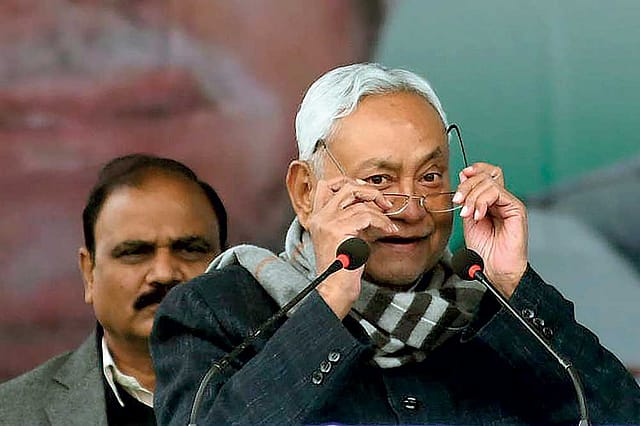Seven Terms as CM and Counting, Nitish Kumar Remains Indispensable

Prime Minister Narendra Modi’s domestic commitments related to campaigning in the Bihar assembly election have ruled out foreign travel including attending the Association of Southeast Asian Nations (ASEAN) which began in Kuala Lumpur on Sunday. External Affairs minister S Jaishankar represented India at the summit and held discussions with United States secretary of state Marco Rubio amid reports that the India-US bilateral trade agreement is inching towards a conclusion.
The PM’s engagements in the Bihar campaign are an obvious reason he chose to address the ASEAN summit through a video call. Irrespective of chatter that Modi might have been keen to avoid meeting Trump, the Bihar election is of crucial importance to the Bharatiya Janata Party and the remainder of the Modi 3.0 tenure. The electoral test comes just past the first year of the PM’s third term and its results will have significant ramifications for BJP’s policies and political decision-making at the Centre. A win will consolidate the NDA’s successes in the Haryana, Maharashtra and Delhi elections that helped offset an underwhelming result in the 2024 Lok Sabha election.
It is not that the Bihar result will necessarily impact the Modi government’s stability as neither Janata Da (U) nor the Telugu Desam Party (TDP) have any incentive to consider alternatives outside the National Development Alliance. But a setback will be a boost to the noisy Opposition which has leveraged the fact that BJP lacks a majority on its own to repeatedly disrupt working of Parliament. Retaining power in Patna is, therefore, crucial for BJP to retain its grip on the Hindi Heartland states of Uttar Pradesh and Bihar. NDA’s strong majorities in these two states are key to BJP’s political dominance.
Dharmendra
28 Nov 2025 - Vol 04 | Issue 49
The first action hero
The Nitish Factor
At the centre of the NDA’s calculations in Bihar is chief minister Nitish Kumar. The Janata Dal (U) leader has not been quite himself for a while with his public interactions marked with increasingly frequent eccentricities. But he remains, as Modi said recently, the political pivot under who’s leadership the NDA allies are contesting the Bihar election. Though the PM understated his own role in mobilising votes for the ruling combine, Nitish Kumr is no doubt indispensable to NDA’s success in Bihar.
Barring a short break, Kumar has been chief minister continuously since November, 2005, when the BJP-JD(U) combine ended Rashtriya Janata Dal leader Lalu Prasad’s long reign. While very much a product of the Mandal revolution, Kumar infused his Other Backward Classes (OBC) politics with a non-adversarial approach towards the forward castes and avoided the pitfalls of corruption, nepotism and poor governance that caused the downfall of other Mandal leaders. The visible improvements in law and order, road connectivity and basic services like health have been a huge change from the days of “Jungle Raj” under the RJD.
Desire for faster growth
Yet, nothing remains still in politics and a desire for faster change is evident. With many Biharis travelling to other states, the comparison with their home state is inevitable. Voters are expressing the view that other Hindi states like UP, Madhya Pradesh and Rajasthan are making faster progress and Bihar needs to do more. There is a yearning for more employment opportunities and regret that Bihar has not undertaken measures to encourage industry or modernise agriculture as other states.
The wages of incumbency can be relentless but for the fact that Nitish Kumar does not elicit strong negative feelings as can happen when voters tire or get annoyed with a dispensation. He commands the loyalty of his Kurmi caste and retains a strong base among other non-Yadav OBCs. His aggressive and shrewd wooing of “maha-dalits” has paid good dividends. While a longing for faster change is discernible, NDA voters are yet to be convinced of the alternative alliance which comprises Congress, Left parties and Mukesh Saini’s Vikassheel Insaan Party besides the RJD. There is a reluctance to abandon a benign administration that delivers welfare benefits and largely allows people to go their own way.
BJP leaders are sparing no effort to remind voters of “Jungle Raj” under RJD and while memories might have been dimmed, the two interregnums of RJD-JD(U) rule – 20 months after the 2015 assembly election and five months from August, 2022 to January, 2023 – have served as reminders that the Lalu clan has not changed its ways. Apart from the Yadav-Muslim block, which is no doubt substantial, other caste groups are not gravitating towards the Mahagathbandan.
The inclusion of Lok Janshakti Party (Ram Vilas) and Jitan Manjhi’s Hindustani Awaam Morcha have shored up NDA’s flanks with these parties representing Paswan and Musahar communities. More than in any other state, parties is Bihar are an agglomeration of caste groups and the NDA applecart is a carefully constructed pyramid of upper castes, OBCs and Dalits with Nitish Kumar as the Talisman that holds these seemingly disparate parts together.
